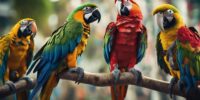What Sets Apart the Different Varieties of Budgerigars (Budgies)?
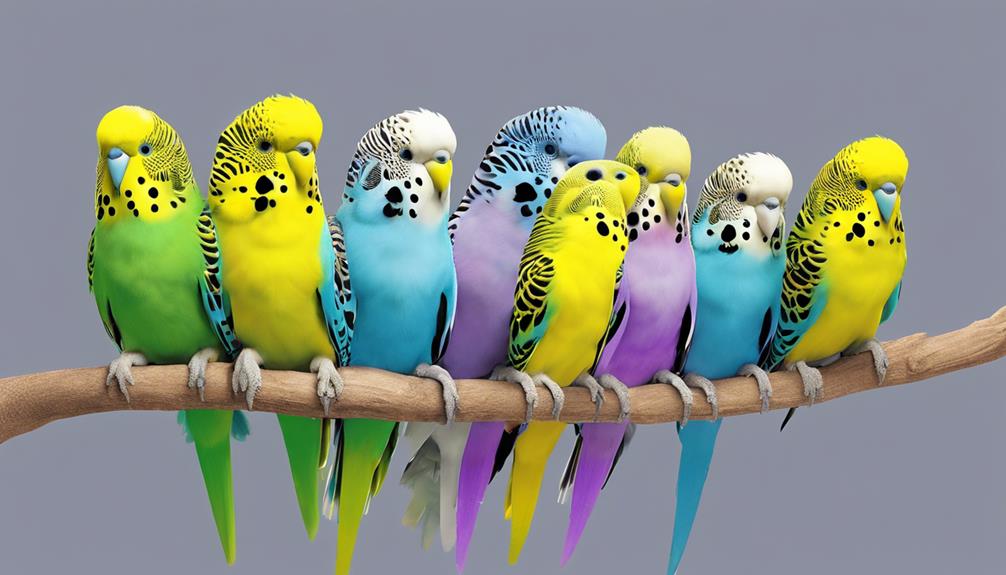
These small parrots exhibit a wide array of colors, including blue, green, yellow, and white. Some budgerigars showcase intricate patterns such as stripes or spots, while others display distinct markings like eye rings or wing spots.
Their diverse appearances make budgerigars popular pets and subjects for aviculture enthusiasts to breed and study.
Color Variations
The color variations of budgerigars play a significant role in defining the diverse and captivating appearances of these popular pet birds. Feather pigmentation in budgerigars is a result of complex genetic interactions that can be manipulated through breeding techniques. Through selective breeding, breeders have been able to enhance and develop specific color mutations, leading to the wide range of hues and patterns seen in budgerigars today.
Feather pigmentation is primarily determined by the presence and distribution of melanin, carotenoid pigments, and structural colors in the feathers of budgerigars. By carefully selecting birds with desired color traits and breeding them together, breeders can influence the expression of these pigments in future generations. This process allows for the creation of unique color variations that cater to the preferences of bird enthusiasts worldwide.
Understanding the mechanisms behind feather pigmentation and applying strategic breeding techniques have enabled breeders to produce an array of stunning color variations in budgerigars, making these birds not only beloved companions but also living works of art.
Pattern Diversity
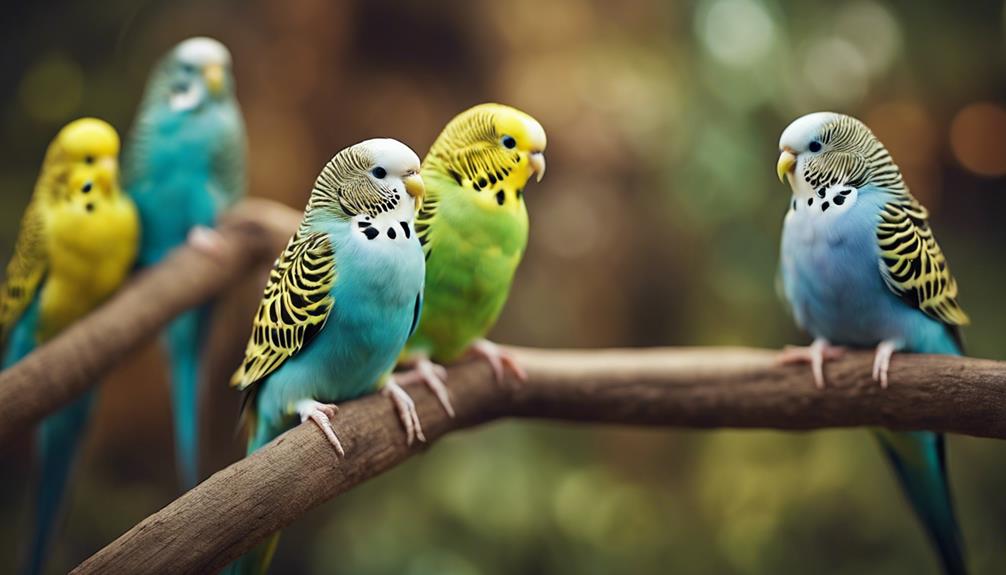
Among budgerigars, pattern diversity showcases an intricate interplay of genetic factors influencing the striking designs found in their plumage. Feather patterns in budgerigars are a result of complex genetic inheritance, where specific genes determine the arrangement and distribution of colors across the bird's body. Through selective breeding practices, breeders can enhance or suppress certain patterns to achieve desired color combinations. This selective breeding has led to a wide array of intricate patterns, ranging from delicate scalloping and intricate lacework to bold stripes and striking spangles.
Color combinations play a crucial role in the overall appearance of budgerigars, with patterns such as opaline, spangle, and clearwing being highly sought after for their unique and visually appealing qualities. By understanding the genetic basis of feather patterns and colors, breeders can predict the potential outcomes of specific pairings, allowing them to create budgerigars with increasingly diverse and captivating patterns. Through careful breeding practices and a deep understanding of genetic inheritance, the pattern diversity seen in budgerigars continues to captivate enthusiasts and breeders alike.
Distinct Markings
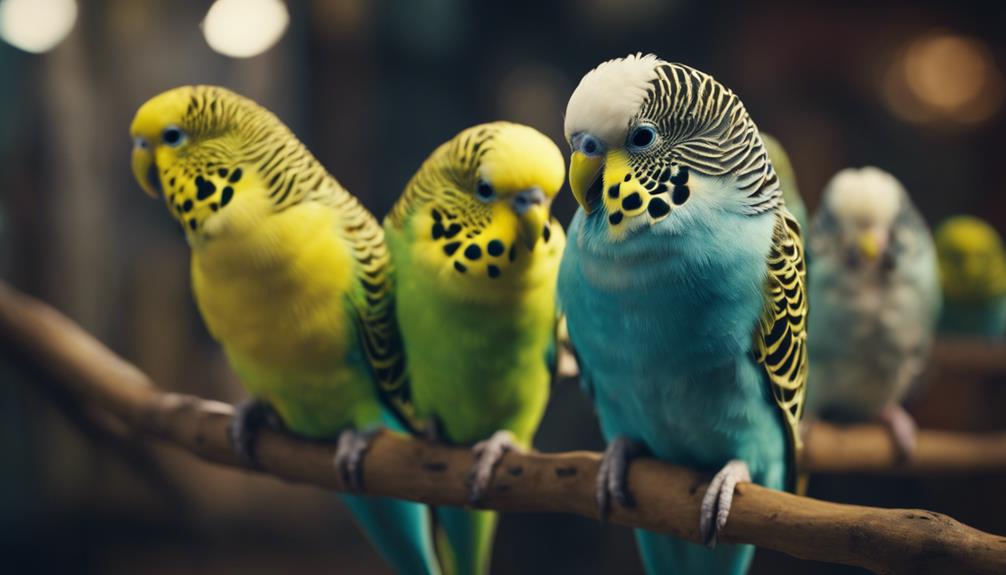
Pattern diversity in budgerigars not only showcases a range of intricate designs but also highlights the presence of distinct markings that contribute to the overall aesthetic appeal of these birds. These markings, found on different parts of the budgerigar's body, play a significant role in distinguishing between various varieties.
Here are some key distinct markings to look out for:
- Wing feather: The wing feathers of budgerigars can exhibit unique patterns and colors, which add a touch of elegance to their appearance.
- Head marking: The head markings of budgerigars vary greatly among different varieties, from bold patterns to subtle markings that give each bird a distinct look.
- Tail feather: The tail feathers of budgerigars often display beautiful patterns and colors that complement the rest of their plumage.
- Body pattern: The body patterns of budgerigars can range from intricate designs to solid colors, enhancing the overall beauty of these birds.
Understanding and appreciating these distinct markings can provide valuable insights into the diverse world of budgerigars and their unique characteristics.
Unique Mutations
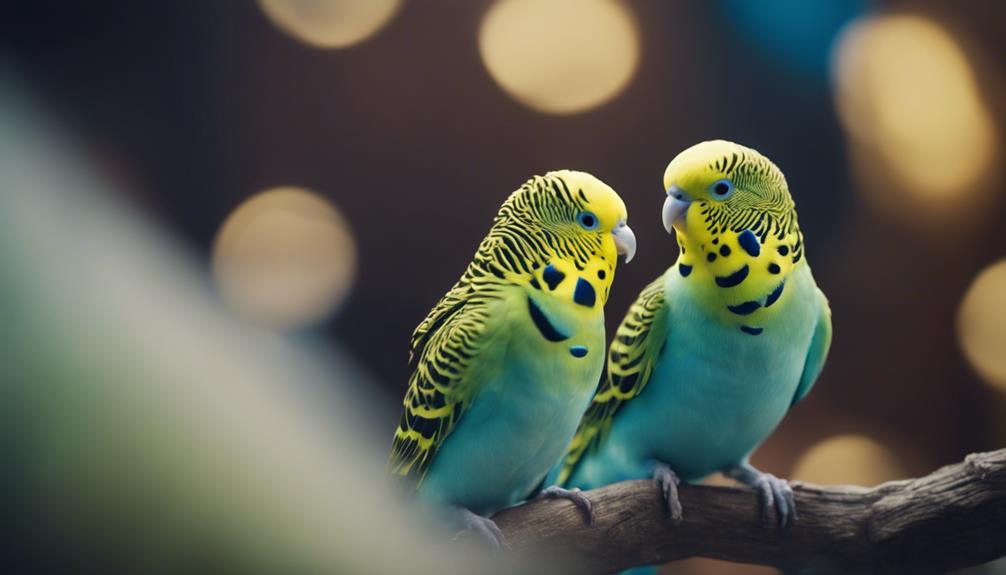
What unique mutations contribute to the diverse genetic makeup of budgerigars? Feather mutations play a significant role in the wide array of budgerigar varieties. Through selective breeding, various feather mutations have been developed, leading to distinct physical characteristics in different budgerigar breeds. These mutations can affect the color, pattern, and texture of the feathers, resulting in unique appearances that set each breed apart.
Genetic mutations also play a crucial role in shaping the physical characteristics of budgerigars. These mutations can impact not only the feathers but also other traits such as size, body shape, and beak structure. Understanding the genetic basis of these mutations is essential for breeders looking to produce specific characteristics in their budgerigars.
Through careful selection and breeding, breeders can predict the potential outcomes of combining different mutations. By understanding how these mutations interact and influence each other, breeders can create new and exciting budgerigar varieties with distinct features that appeal to enthusiasts and collectors.
Recognizing Breeds
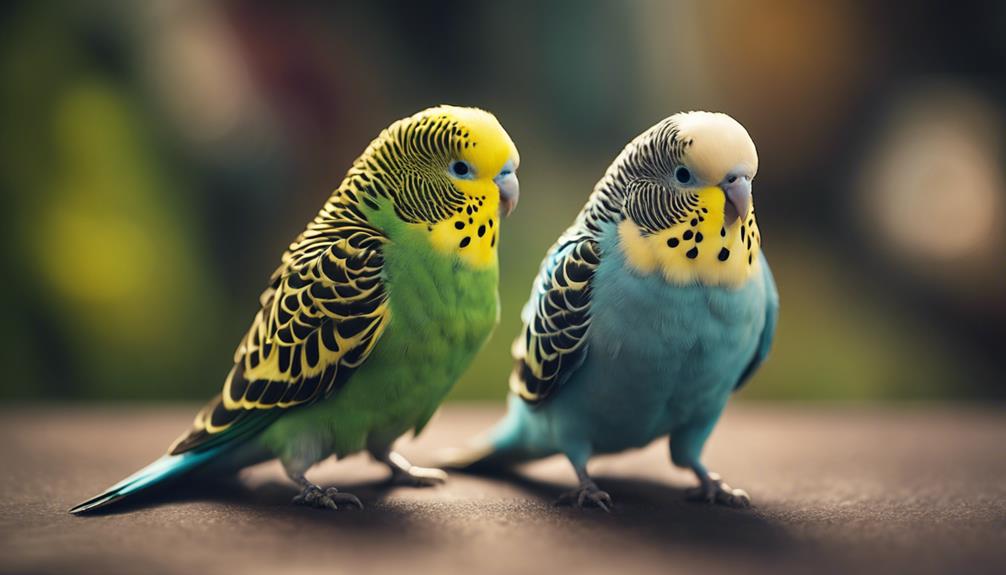
Examining the distinct physical characteristics and genetic markers is essential in recognizing different breeds of budgerigars. Each breed has specific breed characteristics that set them apart from others. Identifying traits play a crucial role in determining the breed standards.
Here are some key points to consider when recognizing different breeds of budgerigars:
- Color Patterns: Different breeds exhibit unique color patterns such as opaline, spangle, or clearwing.
- Head Shape: The shape of the head can vary among breeds, with some having more rounded heads while others have a more streamlined appearance.
- Feather Length: Breed characteristics may include variations in feather length, with some breeds having longer or more abundant feathers.
- Size and Body Structure: Breeds can differ in size and body proportions, with some being more robust while others are more slender and elegant.
Genetic Influences
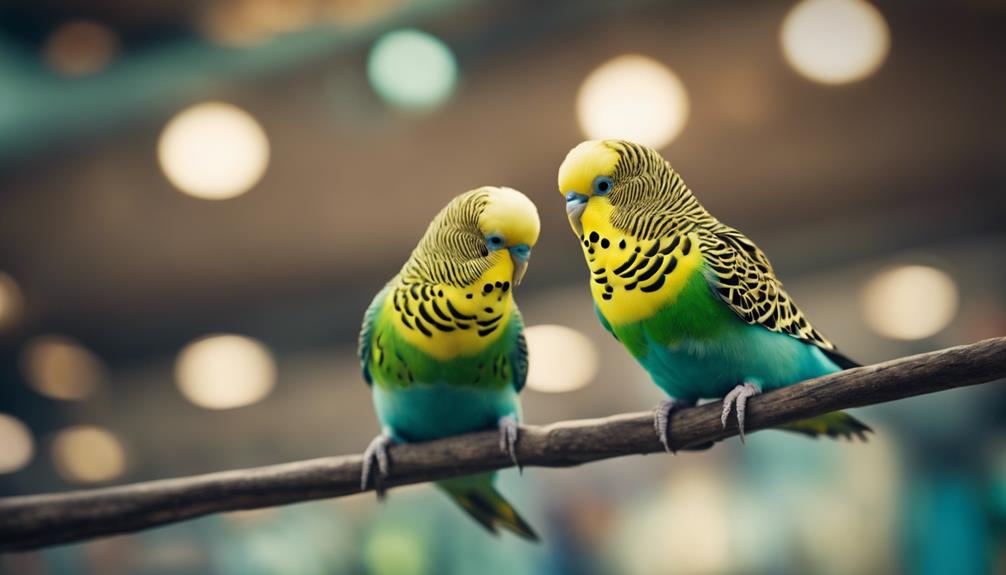
Genetic influences play a crucial role in the diverse color patterns seen in budgerigars.
Inherited traits and mutation-induced physical characteristics contribute significantly to the variations observed within different varieties of budgies.
Understanding the genetic foundations of these traits is essential for breeders and enthusiasts seeking to selectively breed specific characteristics in their budgerigar populations.
Inherited Color Patterns
In understanding the inherited color patterns of budgerigars, researchers have identified specific genetic influences that determine the unique coloring variations found in these birds. Genetic inheritance and selective breeding practices play a crucial role in shaping the color patterns seen in budgies. Here are some key factors influencing the inherited color patterns:
- Melanin Distribution: The distribution of melanin in the feathers determines the intensity and depth of color.
- Pigment Types: Different pigment types, such as eumelanin and pheomelanin, contribute to the variety of colors observed in budgerigars.
- Genetic Mutations: Mutations in specific genes can lead to color variations, creating new and unique patterns.
- Selective Breeding: Controlled breeding practices help accentuate desired color patterns over generations.
Mutation-Induced Physical Traits
The manifestation of physical traits in budgerigars can be directly linked to mutations within their genetic makeup, influencing their outward appearance in distinct ways. Feather mutations play a crucial role in shaping the physical characteristics of budgies, affecting traits such as feather color, patterning, and structure. Understanding genetic inheritance is key for breeders looking to produce budgerigars with specific physical traits. By employing strategic breeding strategies, breeders can capitalize on desirable mutations to enhance certain features in budgies. Whether aiming for vibrant colors or unique feather patterns, knowledge of how mutations influence physical traits allows breeders to selectively breed budgerigars that exhibit the desired characteristics.
| Feather Mutations | Breeding Strategies |
|---|---|
| Color mutations | Selective pairings |
| Pattern mutations | Controlled breeding environments |
| Structural mutations | Genetic testing for specific traits |
Popular Budgie Types
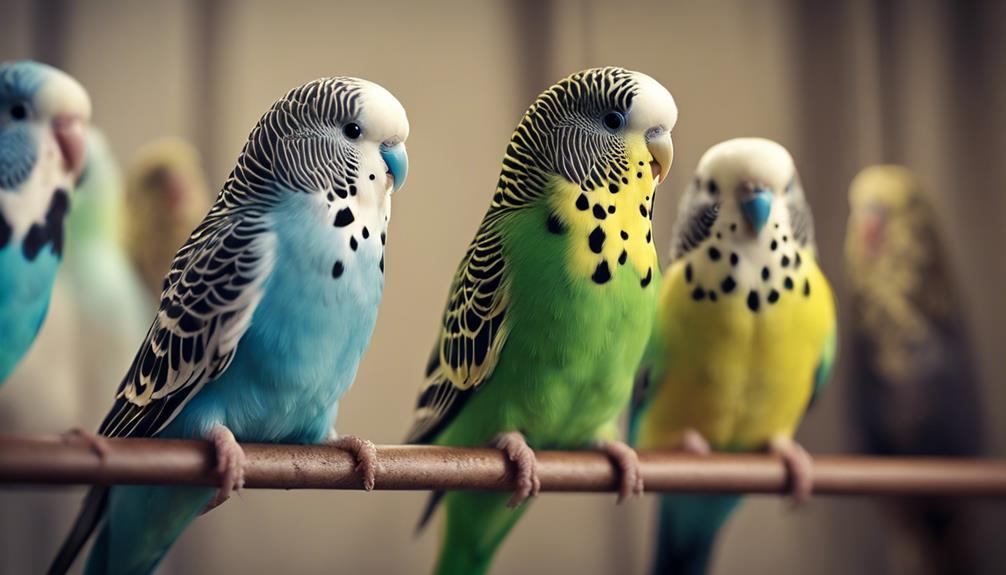
Among the popular budgie types commonly found in aviculture, the recessive pied budgerigars stand out for their distinct color patterns and genetic makeup. These budgies have a unique appearance due to their pied (patchy) feathering, with patches of white or yellow contrasting against their base color.
In addition to the recessive pied variety, there are several other popular budgie types that enthusiasts often seek out for their diverse characteristics:
- Spangle Budgerigars: Known for their striking wing markings that give the appearance of bold, spiky patterns.
- Clearwing Budgerigars: These budgies have a clear body color, with reduced markings on the wings which creates a soft and delicate look.
- Opaline Budgerigars: Characterized by a different feather texture that appears softer and smoother than the traditional budgie feathering.
- Crested Budgerigars: Featuring a distinctive feather crest on top of their heads, adding an elegant and regal touch to their overall appearance.
Each of these popular budgie types offers unique aesthetic qualities that attract bird enthusiasts and breeders alike.
Frequently Asked Questions
Can Budgerigars of Different Colors Interbreed and Produce Offspring With Mixed Colors?
When budgerigars of different colors interbreed, their offspring can inherit a mix of colors due to color genetics. This process creates a diverse palette of hues within the budgie population, showcasing the beauty of mixed offspring.
Are There Any Health Implications Associated With Certain Unique Mutations in Budgerigars?
Certain mutations in budgerigars can lead to health risks such as respiratory issues or neurological disorders. Genetic influences play a role in these mutations, affecting behavior as well. Breeding practices should consider these factors to maintain budgerigar welfare.
How Do Budgerigar Breeders Ensure the Purity of Specific Breeds When Breeding for Specific Traits?
Budgerigar breeders ensure breed purity through meticulous genetic inheritance management and selective breeding techniques. By understanding color combinations and breeding outcomes, they make informed decisions to maintain specific traits, resulting in the consistency of desired characteristics in each breed.
Are There Any Specific Care Requirements for Popular Budgie Types Compared to Other Varieties?
Popular types of budgies have distinct care needs. Specific diet, exercise, grooming, and socialization techniques vary among varieties. Owners must cater to these differences to ensure the well-being and happiness of their feathered friends.
Can Genetic Influences Impact a Budgerigar's Behavior or Temperament in Addition to Its Physical Characteristics?
Genetic influences play a crucial role in shaping a budgerigar's behavior and temperament. Various behavioral traits can be linked to specific genetic factors, illustrating how genetic influences can significantly impact a budgerigar's demeanor and interactions.




